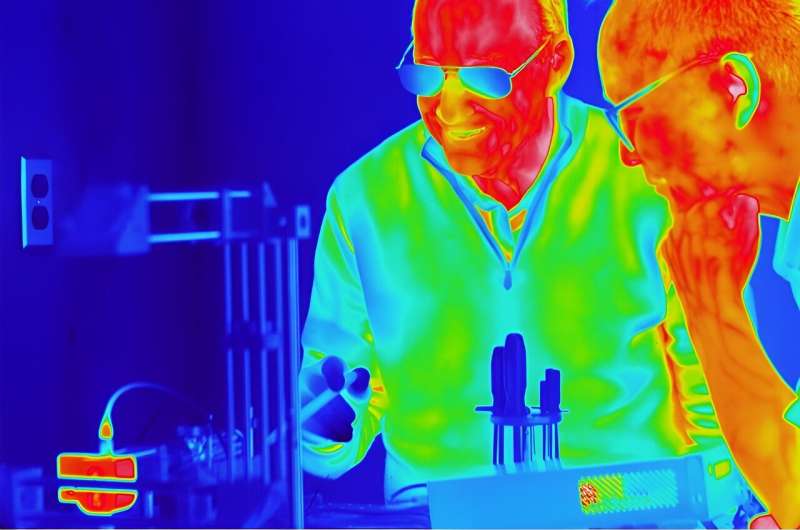This article has been reviewed according to Science X's editorial process and policies. Editors have highlighted the following attributes while ensuring the content's credibility:
fact-checked
trusted source
proofread
Researchers find exception to 200-year-old scientific law governing heat transfer

A team of researchers led by the University of Massachusetts Amherst has recently found an exception to the 200-year-old law, known as Fourier's Law, that governs how heat diffuses through solid materials.
Though scientists have shown previously that there are exceptions to the law at the nanoscale, the research, published in the Proceedings of the National Academy of Sciences, is the first to show that the law doesn't always hold true at the macro scale, and that pure electromagnetic radiation is also at work in some common materials like plastics and glasses.
"This research began with a simple question," says Steve Granick, Robert K. Barrett Professor of Polymer Science and Engineering at UMass Amherst and the paper's senior author. "What if heat could be transmitted by another pathway, not just the one that people had assumed?"
Radiant heat is the heat that we feel from the sun; its electromagnetic waves warm our skin when the sun shines. Diffusion, on the other hand, is how your tea mug will warm your hand after you've poured yourself a fresh cup. For 200 years, scientists have believed that diffusion explains how heat travels through solids. "But sometimes," says Granick, "creativity requires that you put the textbook aside for a moment."
Granick, Shankar Ghosh from the Tata Institute for Fundamental Research and lead author Kaikai Zheng, a senior research fellow at UMass Amherst, surmised that an exception to Fourier's Law might be found in translucent polymers and inorganic glasses. Heat diffuses through both materials, but the team hypothesized that their translucence might also allow energy to radiate through the materials as well.
To test the hypothesis, they situated samples of the materials in a vacuum chamber, which would eliminate the air that is responsible for convective distribution of heat. They then created a pulse of heat in one sample by using a laser to heat a small area, and, in the other sample, heated one side while keeping the other side cold.
They then used a special infrared camera to watch as the heat spread through their samples. In repeating the experiment many times, they kept finding anomalies that Fourier's Law could not entirely explain.
"No one has tried this before," says Zheng. "There's something unexpected happening within translucent polymers."
It turns out that the translucent materials allow energy to radiate internally, interacting with small structural imperfections, which then become secondary heat sources. These secondary heat sources themselves continue to radiate heat through the material.
"It's not that Fourier's Law is wrong," Granick is quick to stress, "just that it doesn't explain everything we see when it comes to heat transmission. Fundamental research like ours gives us an expanded understanding of how heat works, which will offer engineers new strategies for designing heat circuits."
More information: Granick, Steve et al, Exceptions to Fourier's Law at the Macroscale, Proceedings of the National Academy of Sciences (2024). DOI: 10.1073/pnas.2320337121. doi.org/10.1073/pnas.2320337121
Provided by University of Massachusetts Amherst





















